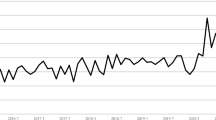Abstract
Identifying price sensitive consumers is an important problem in marketing. We develop a Bayesian multi-level factor analytic model of the covariation among household-level price sensitivities across product categories that are substitutes. Based on a multivariate probit model of category incidence, this framework also allows the researcher to model overall price sensitivity (i.e., indicated by higher-order factor scores) as a function of household-level covariates. All model parameters are estimated simultaneously to circumvent the downward bias resulting from two-stage estimation. The modeling framework is illustrated using scanner panel data from multiple categories of instant coffee.
Similar content being viewed by others
References
Albert, J., & Chib, S. (1993). Bayesian analysis of binary and polychotomous response data. Journal of the American Statistical Association, 88, 669–679.
Ainslie, A., & Rossi, P.E. (1998). Similarities in choice behavior across product categories. Marketing Science, 17(2), 91–106.
Ansari, A., & Jedidi, K. (2000). Bayesian factor analysis for multilevel binary observation. Psychometrika, 65(4), 475–496.
Bartholomew, D.J. (1987). Latent variable models and factor analysis. New York: Oxford University Press.
Blattberg, R.C., Peacock, P., & Sen, S.K. (1976). Purchasing strategies across categories. Journal of Consumer Research, 3(3), 143–54.
Chambers, R.G. (1982). Correlation coefficients from 2×2 tables and from biserial data. British Journal of Mathematical and Statistical Psychology, 35, 216–227.
Chib, S., & Greenberg, E. (1995). Understanding the Metropolis–Hastings algorithm. American Statistician, 49, 327–35.
Chib, S., & Greenberg, E. (1998). Analysis of multivariate probit models. Biometrika, 85(2), 347–361.
Chib, S., Seetharaman, P.B., & Strijnev, A. (2002). Analysis of multi-category purchase incidence decisions using IRI market basket data. Advances in Econometrics, 16, 57–92.
Dey, D.K., & Chen, M.-H. (1998). Bayesian analysis of correlated binary data models. Sankhya Series A.
Duvvuri, S., Ansari, A., & Gupta, S. (2007). Consumers’ price sensitivities across complementary categories. Management Science, 53(12), 1933–1945.
Duvvuri, S. (2009). Modeling covariation in consumer response sensitivities: A multi-category purchase incidence approach. Working Paper, Department of Marketing, SUNY at Buffalo.
Gelfand, A.E. (1996). Model determination using sampling-based methods. In W.R. Gilks, S. Richardson, & D.J. Spiegelhalter (Eds.), Markov chain Monte Carlo in practice (pp. 145–161). London: Chapman and Hall.
Gelman, A., Carlin, J.B., Stern, H.S., & Rubin, D.R. (1996). Posterior predictive assessment of model fitness (with discussion). Statistica Sinica, 6, 733–807.
Geweke, J. (1991). Efficient simulation from the multivariate normal and Student-t distributions subject to linear constraints. In Computing science and statistics: proc. twenty-third symposium on the interface (pp. 571–578). Alexandria: American Statistical Association.
Greene, W.H. (1997). Econometric analysis. Englewood Cliffs: Prentice-Hall.
Grover, R., & Dillon, W. (1985). A probabilistic model for testing hypothesized hierarchical market structures. Marketing Science, 4(Fall), 312–335.
Hansen, K., Singh, V., & Chintagunta, P. (2006). Understanding store-brand purchase behavior across categories. Marketing Science, 25(1), 75–90.
Jensen, A.R. (1998). The g factor: the science of mental ability. Connecticut: Praeger Publishers.
Kannan, P.K., & Wright, G.P. (1991). On “Testing competitive market structures”. Marketing Science, 10(4), 338–347.
Kass, R.E., & Raftery, A.E. (1995). Bayes factors. Journal of American Statistical Association, 90, 773–795.
Kim, B., Srinivasan, K., & Wilcox, R.T. (1999). Identifying price sensitive consumers: The relative merits of demographic vs. purchase pattern information. Journal of Retailing, 75(2), 173–193.
Manchanda, P., Ansari, A., & Gupta, S. (1999). The “Shopping Basket”: A model for multi-category purchase incidence decisions. Marketing Science, 18(2), 95–114.
Montgomery, D.B. (1971). Consumer characteristics associated with dealing: An empirical example. Journal of Marketing Research, 8(1), 118–120.
Neuman, G.A., Bolin, A.U., & Briggs, T.E. (2000). Identifying general factors of intelligence: A confirmatory factor analysis of the Ball Aptitude Battery. Educational and Psychological Measurement, 60(5), 697–712.
Shaffer, G., & Zhang, Z.J. (1995). Competitive coupon targeting. Marketing Science, 14(4), 395–416.
Singh, V., Hansen, K., & Gupta, S. (2005). Modeling preferences for common attributes in multi-category brand choice. Journal of Marketing Research, 42(May), 195–209.
Spearman, C. (1904). General intelligence objectively determined and measured. American Journal of Psychology, 15, 72–101.
Tanner, M.A., & Wong, W.H. (1987). The calculation of posterior distributions by data augmentation (with discussion). Journal of American Statistician, 82, 528–550.
Thurstone, L.L. (1931). Multiple factor analysis. Psychological Review, 38, 406–427.
Thurstone, L. (1938). Primary mental abilities. Psychometric Monographs, 1.
Tierney, L. (1994). Markov chains for exploring posterior distributions. Annals of Statistics, 22, 1701–1762.
Urban, G.L., Johnson, P.L., & Hauser, J.R. (1984). Testing competitive market structures. Marketing Science, 3(2), 83–112.
Vilcassim, N.J. (1989). Extending the Rotterdam Model to test hierarchical market structures. Marketing Science, 8(2), 181–190.
Webster, F.E. Jr. (1965). The ‘Deal-Prone’ consumer. Journal of Marketing Research, 2(2), 186–189.
Author information
Authors and Affiliations
Corresponding author
Additional information
The authors thank Asim Ansari, Don Lehmann, and Kamel Jedidi, Columbia University; Sunil Gupta, Harvard University; and Gary Russell, University of Iowa, for their valuable comments.
Rights and permissions
About this article
Cite this article
Duvvuri, S.D., Gruca, T.S. A Bayesian Multi-Level Factor Analytic Model of Consumer Price Sensitivities Across Categories. Psychometrika 75, 558–578 (2010). https://doi.org/10.1007/s11336-010-9167-3
Received:
Revised:
Published:
Issue Date:
DOI: https://doi.org/10.1007/s11336-010-9167-3




